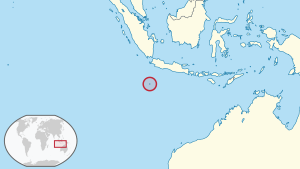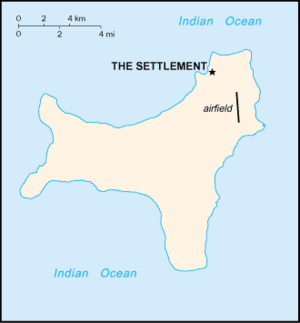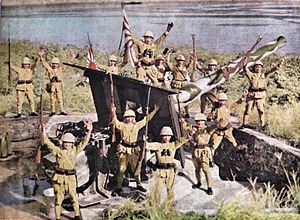Battle of Christmas Island facts for kids
Quick facts for kids Battle of Christmas Island |
|||||||||
|---|---|---|---|---|---|---|---|---|---|
| Part of the Indian Ocean theatre and Pacific Theatre of World War II | |||||||||
 Christmas Island |
|||||||||
|
|||||||||
| Belligerents | |||||||||
| Commanders and leaders | |||||||||
| Unknown | |||||||||
| Strength | |||||||||
| Land: 32 infantry Sea: 1 submarine |
Land: 850 infantry Sea: 3 light cruisers 8 destroyers 1 oiler 2 troop transports Air: Unknown aircraft |
||||||||
| Casualties and losses | |||||||||
| 27 captured | 1 light cruiser damaged | ||||||||
|
|||||||||
The Battle of Christmas Island was a small but important event during World War II. It happened on March 31, 1942. During this battle, soldiers from the British Indian Army rebelled against their British officers. This helped Imperial Japanese Army troops take over Christmas Island easily. However, a United States Navy submarine, the Seawolf, badly damaged a Japanese ship during the invasion.
Why Christmas Island Was Important
Christmas Island was a British territory located south of Java. It was important for two main reasons. First, it was a good spot to control the eastern Indian Ocean. Second, the island had lots of phosphate. This mineral was very important for Japanese industries.
Since 1900, people had been mining phosphate on the island. At the time of the battle, about 1,000 Chinese and Malay workers lived there. They worked under a small group of British leaders. There were also about 100 women and 200 children on the island.
After Japan took over Java in 1942, they decided to invade Christmas Island. This plan was called "Operation X." Rear Admiral Shōji Nishimura led the Japanese invasion fleet. His main ship was the light cruiser Naka.
The Japanese fleet was very strong. It included two more light cruisers, eight destroyers, an oiler ship, and two transport ships. These ships carried about 850 soldiers.
The British forces on Christmas Island were much smaller. They had only one old 6-inch gun. The British army group had 32 soldiers. This group included a British officer, Captain L. W. T. Williams, an Indian officer, 27 Indian gunners, and four British enlisted men.
Before the battle, some of the Indian soldiers rebelled. They believed Japanese messages that promised to free India from British rule. On March 11, they killed Captain Williams and the four British enlisted men. They also captured other Europeans on the island.
The Battle Begins
On March 31, 1942, Japanese bombers attacked Christmas Island. They destroyed the radio station. The rebelling soldiers on the island quickly showed they would surrender. They raised a white flag before the Japanese troops even landed.
The Japanese landing force of 850 men came ashore at Flying Fish Cove without any fighting on land.
However, the battle was not over at sea. At 9:49 AM, the US Navy submarine USS Seawolf fired torpedoes at the Japanese cruiser Naka, but missed. The next morning, Seawolf tried again, firing at another Japanese ship, Natori, and missed again.
Later that evening, Seawolf fired its last two torpedoes. One of them hit the Naka on its side. The damage was so bad that Naka had to be pulled back to Singapore by another ship. It then had to go to Japan for a whole year of repairs. After the hit, other Japanese ships dropped depth charges for over nine hours to try and sink the US submarine, but Seawolf managed to escape.
The Japanese ship Natori returned to Christmas Island. It took most of the Japanese soldiers away, leaving only a small group of 20 men. The Japanese loaded the valuable phosphate rock onto their transport ships.
After the Battle
After the Japanese took over, they tried to make the Chinese and Malay workers produce phosphate. But many workers ran away into the island's forests. The soldiers who had rebelled also became laborers. However, phosphate production was very limited. It stopped completely after a Japanese ship was sunk at the wharf in November 1942.
By December 1943, more than 60% of the island's people, including the European prisoners, were moved to Java. After World War II ended, the British took control of Christmas Island again in October 1945.
After the war, seven of the Indian soldiers who had rebelled were found and put on trial in Singapore. Five of them were sentenced to death in 1947. However, India and Pakistan became independent countries shortly after. Because of this, the death sentences were changed to life imprisonment. In 1955, the six prisoners were sent to Pakistan, and the British government stopped being involved in their case.
See also
- Cocos Islands mutiny



